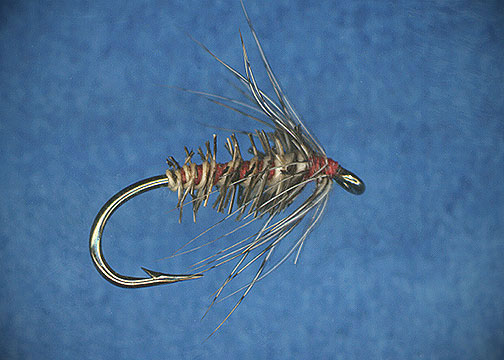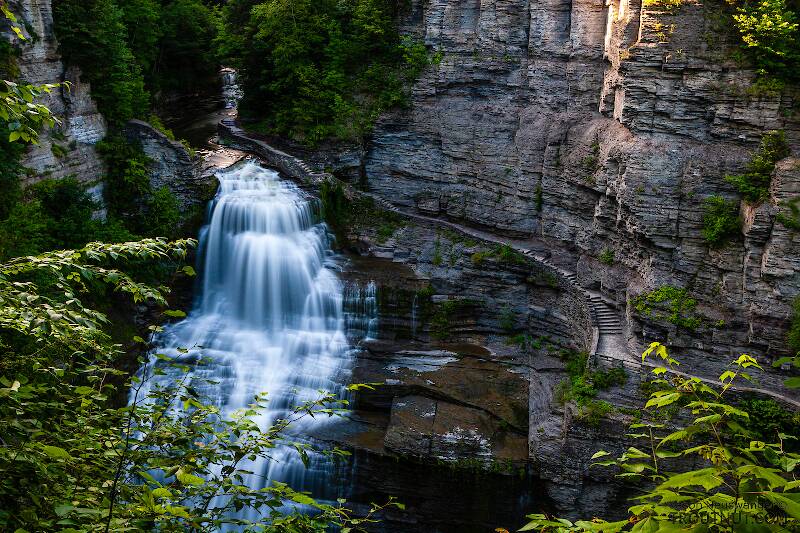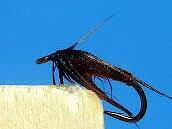
Hex Mayflies
Hexagenia limbata
The famous nocturnal Hex hatch of the Midwest (and a few other lucky locations) stirs to the surface mythically large brown trout that only touch streamers for the rest of the year.
Featured on the forum

With a bit of help from the microscope, this specimen keys clearly and unsurprisingly to Hydropsyche.

Troutnut is a project started in 2003 by salmonid ecologist Jason "Troutnut" Neuswanger to help anglers and
fly tyers unabashedly embrace the entomological side of the sport. Learn more about Troutnut or
support the project for an enhanced experience here.
Sayfu
Posts: 560
Posts: 560
Sayfu on Aug 27, 2012August 27th, 2012, 6:09 am EDT
Hope to accumulate some Ruffed Grouse feathers on Thurs. out here West. That's the opener for our Forest Grouse season. I see a supply house has Ruffed Grouse paired wings for sale, for tailing, legs, shellbacks. I've never used any for that purpose. I have body feathers around for my softhackles, and seldom use them preferring my Hun feathers instead.
PaulRoberts on Aug 27, 2012August 27th, 2012, 6:15 am EDT
I have a lot of grouse feathers -mostly ruffs, but some dusky's/blue's now. They are a very soft feather. I use them for legs, twisted bodies, and the aftershaft and "bou". I've use the tailfeathers to fletch arrows too.
Softhackle on Aug 27, 2012August 27th, 2012, 8:28 am EDT
Hi,
Ruffed Grouse feathers are wonderful! There's many usable feathers including the tail. In the past, I've used these for a fly called the Breadcrust Nymph, but it's really a wingless wet.
http://www.charliesflyboxinc.com/flybox/detail.cfm?parentID=86
Mark
Ruffed Grouse feathers are wonderful! There's many usable feathers including the tail. In the past, I've used these for a fly called the Breadcrust Nymph, but it's really a wingless wet.
http://www.charliesflyboxinc.com/flybox/detail.cfm?parentID=86
Mark
"I have the highest respect for the skilled wet-fly fisherman, as he has mastered an art of very great difficulty." Edward R. Hewitt
Flymphs, Soft-hackles and Spiders: http://www.troutnut.com/libstudio/FS&S/index.html
Flymphs, Soft-hackles and Spiders: http://www.troutnut.com/libstudio/FS&S/index.html
Sayfu
Posts: 560
Posts: 560
Sayfu on Aug 27, 2012August 27th, 2012, 9:31 am EDT
softhackle. Live and learn with this fly tier. I think I get my most uses for materials by reading the supply house descriptions of their materials, and uses. I get very tunnel visioned. I've shot lots of Ruffs, and throw in some body feathers in a bag, and that's it.
DUBBN on Aug 27, 2012August 27th, 2012, 1:58 pm EDT
I had my chance to run over a Blue/Dusky a few weeks ago. I like their smaller wing feathers for an olive flymph that I use. I know the fish dont care if it's hen or grouse, but I like the looks of different feathers when I dress a Soft hackle pattern.
That being said, plane jane brown hen hackle is still my favorite.
That being said, plane jane brown hen hackle is still my favorite.
It's OK to disagree with me. I can not force you to be right.
Sayfu
Posts: 560
Posts: 560
Sayfu on Aug 27, 2012August 27th, 2012, 2:34 pm EDT
There is quite a distinction between a chicken hen feather, and wild bird feahers. The hen feather can disappear when wet where the wild bird feather retains its form. And that comes from Mike Lawson when he ties a spent caddis for example. He uses several matched partridge feathers for the wing pinched. Says to not use chicken hen feathers.
DUBBN on Aug 27, 2012August 27th, 2012, 3:13 pm EDT
I guess I would have to say that when Mike Lawson can tell me exactly what a fish can actually see, I might listen to him. Until then, I will stick to hen feather when it suits me, not Mike.
It's OK to disagree with me. I can not force you to be right.
Sayfu
Posts: 560
Posts: 560
Sayfu on Aug 27, 2012August 27th, 2012, 5:06 pm EDT
You missed the point. Mike is saying that wild bird feathers retain their form much better than the domestic chicken. Suit yourself on what you want to use.
Entoman on Aug 28, 2012August 28th, 2012, 12:52 am EDT
Dubbn & Sayfu -
I think it's possible that the two of you are working at cross purposes. Brown hen hackle (the genetic stuff sold in shops) is like soft rooster and doesn't have the nasty habit of "marrying" underwater with limp lifelessness. It happens to be my favorite for classic collared nymphs like the Prince and Zug Bug. Grouse, partridge & similar wild bird feathers have similar attributes. An often used "substitute" for partridge is what's usually referred to as "India Game Hen." It is a cool looking mottled feather on the neck but a relatively lifeless, soggy looking material in the water. It is India game hen that I believe Lawson was referring to.
I'd sure like to read Softhackle's opinion on the matter as our forum's resident expert on all things "soft hackle".
Regards,
I think it's possible that the two of you are working at cross purposes. Brown hen hackle (the genetic stuff sold in shops) is like soft rooster and doesn't have the nasty habit of "marrying" underwater with limp lifelessness. It happens to be my favorite for classic collared nymphs like the Prince and Zug Bug. Grouse, partridge & similar wild bird feathers have similar attributes. An often used "substitute" for partridge is what's usually referred to as "India Game Hen." It is a cool looking mottled feather on the neck but a relatively lifeless, soggy looking material in the water. It is India game hen that I believe Lawson was referring to.
I'd sure like to read Softhackle's opinion on the matter as our forum's resident expert on all things "soft hackle".
Regards,
"It's not that I find fishing so important, it's just that I find all other endeavors of Man equally unimportant... And not nearly as much fun!" Robert Traver, Anatomy of a Fisherman
Feathers5
Posts: 287
Posts: 287
Feathers5 on Aug 28, 2012August 28th, 2012, 5:37 am EDT
Hen Back does get clumpy when used for wet flies. It's very soft. I like something a little stiffer. Actually, I think India Hen Neck is stiffer. We need softhackle to weigh in concerning these feathers.
Bruce
Bruce
Sayfu
Posts: 560
Posts: 560
Sayfu on Aug 28, 2012August 28th, 2012, 5:54 am EDT
Actually, and the problem I have is memory, and the problem may be specific to the pattern....Lawson ties a spent caddis using a pair of hun hackle feathers back to back that will slightly splay out. He pinches them runs the off hand over them getting as much hackle into the wings as he can, and then applies them over the body. He told us that if you use those hen hackles (brown) as a substitute they tend to "disappear" in the water as apposed to the hun hackles. He then says that is the difference between wild birds, and the domestic hen. Also said he didn't know why. Maybe wrapping the feather as for a soft hackle is a different deal. ??
Oldredbarn on Aug 28, 2012August 28th, 2012, 7:44 am EDT
I had my chance to run over a Blue/Dusky a few weeks ago.
Real "sporting" there, sport?
Spence
"Even when my best efforts fail it's a satisfying challenge, and that, after all, is the essence of fly fishing." -Chauncy Lively
"Envy not the man who lives beside the river, but the man the river flows through." Joseph T Heywood
"Envy not the man who lives beside the river, but the man the river flows through." Joseph T Heywood
Sayfu
Posts: 560
Posts: 560
Sayfu on Aug 28, 2012August 28th, 2012, 8:29 am EDT
I meant to say, "as apposed to the hen hackles, not hun hackles. Why? I think maybe because there is more length, underfiber that gets included in the Hun, verses the hen hackles. I looked at my hen hackle soft fiber backs, and a fairly big, longer feather does not have that long of fibers, as my fatter shaped Hun hackles...but just a guess.
DUBBN on Aug 28, 2012August 28th, 2012, 10:33 am EDT
I had my chance to run over a Blue/Dusky a few weeks ago.
Real "sporting" there, sport?
Spence
I didn't take the oppurtunity to do that. Just said I had the chance.
Real "BIG" of you to chime in, sport
It's OK to disagree with me. I can not force you to be right.
Softhackle on Aug 28, 2012August 28th, 2012, 11:44 am EDT
Interesting!
I've used hen back, Partridge, Ruffed Grouse. I like them all for hackles. I love Coq de leon Hen hackles, especially the mottled type. Looks like Partridge, but you get smaller sizes.
Sayfu,
It takes a little practice to put that Breadcrust together, but I can tell you, that fly is murder.
Mark
I've used hen back, Partridge, Ruffed Grouse. I like them all for hackles. I love Coq de leon Hen hackles, especially the mottled type. Looks like Partridge, but you get smaller sizes.
Sayfu,
It takes a little practice to put that Breadcrust together, but I can tell you, that fly is murder.
Mark
"I have the highest respect for the skilled wet-fly fisherman, as he has mastered an art of very great difficulty." Edward R. Hewitt
Flymphs, Soft-hackles and Spiders: http://www.troutnut.com/libstudio/FS&S/index.html
Flymphs, Soft-hackles and Spiders: http://www.troutnut.com/libstudio/FS&S/index.html
Sayfu
Posts: 560
Posts: 560
Sayfu on Aug 28, 2012August 28th, 2012, 12:20 pm EDT
I definitely know of the Breadcrust, somewhat can picture it, and I think it is generally tied on a somewhat bigger hook, say #12..not #16's etc. I don't believe. I'll have to look it up. It is an oldie, but goodie going back some years I do believe.
Sayfu
Posts: 560
Posts: 560
Sayfu on Aug 28, 2012August 28th, 2012, 3:31 pm EDT
Softhackle. You are more articulate, and have more patience than I. I looked up the Breadcrust, and the directions for preparing the body quill. I immediately began thinking of a substitute.
Softhackle on Aug 28, 2012August 28th, 2012, 7:19 pm EDT

Hook: Mustad 3399A #12
Thread: 8/0 Orange Uni Thread
Hackle: Partridge
Body: two feathers taken from the Bastard Wing area of the Partridge. They are stripped off on the darker side, leaving the other brown mottled side. These are then trimmed with a scissor, close to the stem. When wrapped the trimmed barbs should stand out as seen. Wrap one stem first, then go in-between the wraps to fill-in the gaps of the first stem.
Try this instead!
Mark
"I have the highest respect for the skilled wet-fly fisherman, as he has mastered an art of very great difficulty." Edward R. Hewitt
Flymphs, Soft-hackles and Spiders: http://www.troutnut.com/libstudio/FS&S/index.html
Flymphs, Soft-hackles and Spiders: http://www.troutnut.com/libstudio/FS&S/index.html
Sayfu
Posts: 560
Posts: 560
Sayfu on Aug 29, 2012August 29th, 2012, 6:07 am EDT
The directions I got were for the tail fibers, and to be soaked until wrapped but first split with a razor blade? I didn't quite understand the process, and they had pictures on how to, but that's nothing new for me.
Have you ever had any thoughts about tails as providing a camouflage for the hook? Years ago Borger made the comment that tails can possibly incorporate the hook into the profile, and not have the hook bend/point be a visible part of the profile. It has been in my mind ever since. I will try the your wing concept. I can do that.
Sayfu
Posts: 560
Posts: 560
Sayfu on Aug 29, 2012August 29th, 2012, 7:54 am EDT
Mark..Thanks for the pattern. I tied some up, and preparing the wing stem was a lot easier than the tail stem of the grouse. They look good, and I used one of my glass beads at the head..bought some "root beer" small beads from Cabelas recently.
Quick Reply
Related Discussions
Topic
Replies
Last Reply
13
Mar 30, 2021
by Taxon
by Taxon






